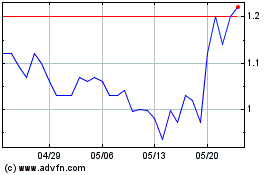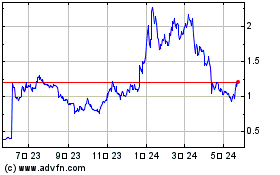Ethereum Blockchain’s Q1 2024 Success: Unveiling The Factors Behind The $370M Profit Surge
2024年4月19日 - 9:00AM
NEWSBTC
Not only has Ethereum (ETH) seen an impressive rise of nearly 100%
in the first quarter of 2024 in terms of price action, but the
Ethereum blockchain has also generated substantial profits of up to
$369 million during this period. This unexpected profitability has
raised questions about how a blockchain like Ethereum can be
profitable. Ethereum Revenue Potential As noted in a recent
analysis by the on-chain data platform Token Termina, the
collection of transaction fees is a critical aspect of Ethereum’s
business model. All network users are required to pay fees in
ETH when interacting with applications on the blockchain, which
serves as an important source of revenue for Ethereum. Once
transaction fees are paid, a portion of the ETH is burned and
permanently removed from circulation. This process, commonly
referred to as “ETH buyback,” benefits existing ETH holders, as the
reduction in supply increases the scarcity and value of the
remaining ETH tokens. Thus, the daily burning of ETH contributes to
the economic benefit of those holding Ethereum. Related Reading:
Here’s What Would Happen If The Bitcoin Price Fell Below $58,000 In
contrast to the burning of ETH, Ethereum also issues new ETH tokens
as rewards to the network’s validators for each new block added to
the blockchain. These rewards are similar to traditional
stock-based compensation and are designed to incentivize validators
to secure and maintain the network’s integrity. Nonetheless,
it’s important to note that the issuance of new ETH tokens dilutes
the holdings of existing ETH holders. According to Token Terminal,
the difference between the daily USD value of the burned ETH
(revenue) and the newly issued ETH (expenses) represents the daily
earnings for existing ETH holders, essentially the Ethereum
blockchain owners. This calculation allows for the determination of
Ethereum’s profitability on a day-to-day basis. Reduced Transaction
Costs Drive $3.3 Billion Growth In addition to the overhauled
revenue model implemented by the Ethereum blockchain, the launch of
the much-anticipated Dencun upgrade to the Ethereum ecosystem at
the end of the first quarter of 2024 brought significant changes,
including the introduction of a revolutionary data storage system
called blobs. This upgrade has reduced congestion on the
Ethereum network and significantly reduced transaction costs on
Layer 2 networks such as Arbitrum (ABR), Polygon (MATIC), and
Coinbase’s Base. Implementing the Dencun upgrade, alongside
the adoption of blobs and Layer 2 networks, has significantly
impacted Ethereum’s revenue. According to Token Terminal
data, the blockchain’s revenue has witnessed an 18% annualized
increase, amounting to an impressive $3.3 billion. These revenue
gains can be attributed to reduced transaction costs, making
Ethereum a more attractive platform for users and developers.
Related Reading: Bitcoin To $455,000: Expert Echoes Previous
Halving Pattern Despite the positive revenue growth, it is
essential to acknowledge the impact of market corrections and
dampened investor interest in the second quarter of 2024.
Over the past 30 days, Ethereum’s revenue has declined by over 52%.
This downturn can be attributed to the broader market dynamics and
the temporary decrease in investor enthusiasm. Examining the
data over the past 30 days, Ethereum’s market cap (fully diluted)
has decreased by 15.2% to $358.47 billion. Similarly, the
circulating market cap has declined by 15.2% to reach the same
value. Additionally, the token trading volume over the past
30 days has declined 18.6%, totaling $586.14 billion. ETH is
trading at $3,042, up 0.4% in the last 24 hours. It remains to be
seen whether these changes and the reduction in fees will have the
same effect in the second quarter of the year, and how this,
coupled with a potential increase in trading volume, can push the
ETH price to higher levels. Featured image from Shutterstock,
chart from TradingView.com
Arbitrum (COIN:ARBUSD)
過去 株価チャート
から 4 2024 まで 5 2024

Arbitrum (COIN:ARBUSD)
過去 株価チャート
から 5 2023 まで 5 2024
